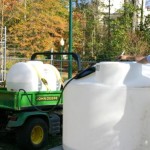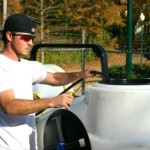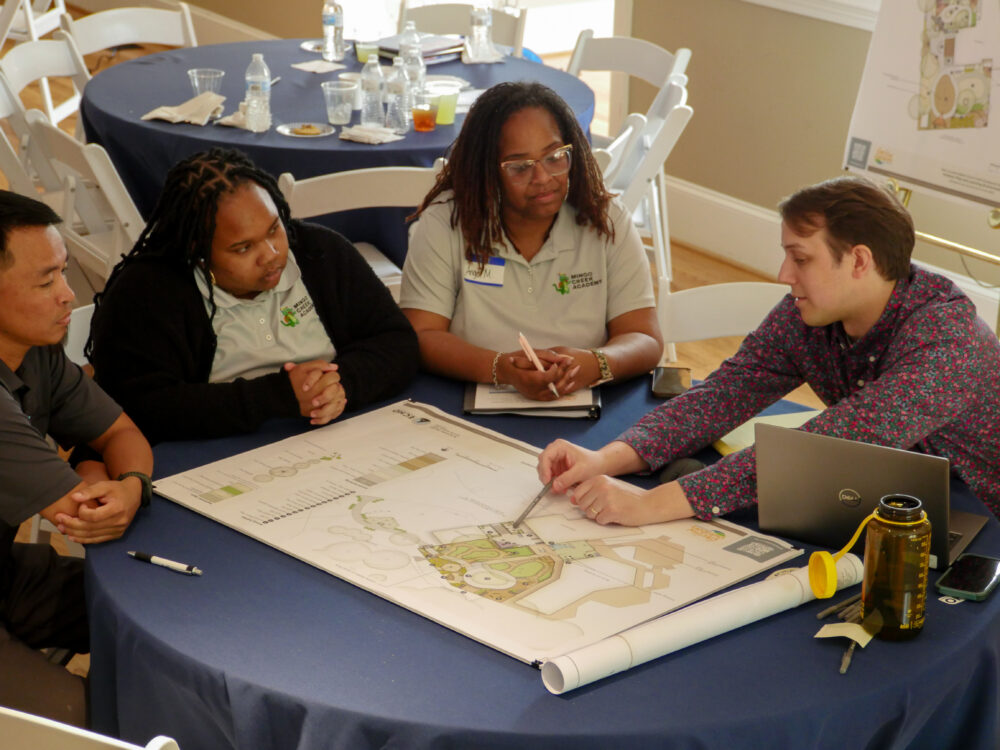We have much more to do and your continued support is needed now more than ever.
Let It Rain!
NWF
October 13, 2009

Letting the campus flowers shrivel and die was not an option, so the Georgia college turned to an ancient technology that is gaining popularity on American campuses: rainwater harvesting. A local business donated two 1,000-gallon tanks to collect rain from the gutters on the roof of the facilities building, and this free H2O is now used to water all of the campus flower beds. “We don’t hook hoses to buildings anymore,” Vitale says.
To improve their sustainability, and cut municipal water bills, colleges and universities including Harvard, the Massachusetts Institute of Technology, the University of Arizona, George State, Abilene Christian University and numerous others have installed rooftop rain harvesting systems in recent years. The water is used for everything from irrigating grounds to flushing toilets and other non-potable uses.
Harvesting rain has the added benefit of reducing carbon emissions. Municipal water is embedded with energy, which is used to extract, treat and pump water to customers. “The energy costs of using harvested rainwater are significantly lower” than for municipal water, says Robert Goo, an Environmental Protection Agency specialist who promotes rainwater harvesting as part of the agency’s Low Impact Development program. Water delivery consumes three percent of the nation’s electricity, according to a 2008 EPA report, and reducing potable water use by 10 percent could save 300 billion kilowatt hours of electricity annually.
Indigenous people have harvested rainwater for millennia (archaeologists have uncovered sophisticated cisterns built by the Anasazi cliff dwellers of the Southwest), and rain harvesting is widely employed in the developing world. But rain is rarely collected in the United States and other industrialized nations, where citizens get most of their water from centralized municipal water systems.
For most Americans, turning the tap is like flipping on a light switch. This easy access to H2O has made Americans water gluttons: we use more water per capita than any other nation-about 165 gallons a day. Much of this tap water, which is treated to Safe Drinking Water Act standards, is used outdoors. Using potable drinking water for irrigation is like washing your car with Perrier-expensive and unnecessary.
More frequent droughts and long-term climatic changes in the West and Southwest show this profligate use of potable water to be unsustainable. In response, municipalities and states in arid regions are pushing homeowners, businesses and government institutions to collect rain. In 2010, Tucson will begin requiring commercial properties to use at least 50 percent harvested rainwater to irrigate grounds. This year, Colorado rewrote its outdated water laws to allow rain harvesting by homeowners. New Mexico, Arizona and Texas are also pushing rainwater harvesting.
“We just went about eight months without any rain, so water is a hot commodity here,” says Lee Fuiman, director of the University of Texas’ Marine Science Institute. Located in Port Aransas, the institute’s new state-of-the-art laboratory-the Mission-Aransas National Estuarine Research Reserve Headquarters-will feature a rooftop rain harvesting system when opened in 2011. Water collected in four 5,000-gallon cisterns will be used to irrigate grounds and recharge the local aquifer.
Texas, which has published the Texas Manual on Rainwater Harvesting, is a hotbed of activity. The state provides tax incentives for harvesting, and some municipalities including Austin sell rain barrels to consumers at reduced cost. In response, the University of Texas system is encouraging rainwater harvesting for all new buildings, such as the Engineering Research Complex at UT-Arlington.
“Water is a precious commodity in Central Texas,” says Andy Adkins, project manager for new construction in the University of Texas system. “We’ve been in an exceptional drought in the last two years. It’s beyond extreme.”
With a combined 67,000 students and faculty, University of Texas-Austin is one of the state capital’s biggest water users. By including a rain harvesting system on the roof of the new Belo Center for New Media, which is currently being designed, the school can help relieve stress on Austin’s municipal water supply. “Harvesting rain means the city has to do less water treatment, which will postpone or eliminate the need to build new treatment plants,” Adkins says.
In future years the university will add meters to track how much municipal water is saved by using rain water. “It does cost more initially, but it’s a pretty quick payback,” Adkins says. “And water is not going to get cheaper in the future.”
Texas’ county extension offices have installed hundreds of demonstration systems statewide, and the Rainwater Harvesting Task Force trains master gardeners so they can pass on the knowledge. “Rainwater harvesting is the most logical place for us to increase our useable water supply,” says John Smith, a Texas AgriLife Extension specialist who conducts workshops on rain harvesting.
One of the newest campus installations is a 6,000-square-foot rooftop system installed on the Texas A&M Field Day Barn in 2009. The system, which gathers water for restrooms, cost $3,500 and will pay for itself quickly, Smith says. “It was much cheaper than drilling a well.”
In the Northeast, where water is abundant, universities including MIT, Harvard, Princeton and Yale are harvesting rain to minimize storm runoff. Storm water often flows untreated into the nearest waterways, carrying everything from dog poop to motor oil. When dumped into municipal sewer systems, storm water overflows can lead to the discharge of untreated sewage into rivers and bays. Storm runoff is a leading cause of harmful algal blooms and coastal pollution.
“Our system blends storm water management with rainwater harvesting,” says Nicole Holmes, project manager for Nitsch Engineering, which designed the rain harvesting system on Yale’s award-winning Kroon Hall. Rain is collected from the roof and grounds, minimizing the amount that flows into storm drains, and is pumped through a pond where aquatic plants including cattails and lotuses serve as “bio-filters” that extract phosphorous, nitrogen and contaminants. The harvested water is used to flush the building’s toilets, saving about half-a-million gallons of municipal water annually.
Portland State University’s Epler Hall diverts storm water from its rooftop into a bed of aesthetically pleasing river rocks on a public plaza. The water is then filtered through sand and treated with ultraviolet light before being pumped back into Epler Hall for use in toilets-saving 110,000 gallons of municipal water and lowering the university’s water bill by about $1,000 annually.
No reliable data exist on the number of rain harvesting systems installed nationwide, but it’s “definitely on the rise,” says Eliza Vermillion, spokeswoman for the nonprofit American Rainwater Catchment Systems Association. “There is huge growth in this field. Most of the activity is in places that have droughts or are experiencing water restrictions.”
Why has it taken so long for the nation to warm up to the idea of collecting rain? State and local regulations are the main hurdles. “The regulatory authorities want to make sure they are not jeopardizing public health,” says Goo of the EPA. Roof water can contain bird droppings, atmospheric pollutants and other toxins.
To be used indoors, even just for toilets, harvested rainwater must be treated to meet government safety regulations. “Some of these systems are way over-designed,” Holmes says. “We err on the side of caution in case some crazy person decides to drink water out of the toilet.”
Rain harvesting will become more widespread as regulators become more familiar with its benefits, experts predict. “I believe we’re at the inception of a waterfall of programs, so to speak, to promote rainwater harvesting,” Goo says.

Duke began auditing its water use and implementing various conservation measures following the 2007 drought. The school now collects rain from the roof of its Fitzpatrick Science Center and from the campus chilled water plant. It recycles water used to wet down the artificial turf on the field hockey field, where an underground collection system has been installed. “We get about 85 percent of that field hockey water back,” Noonan says. Combined, all the measures have paid off: In August, the driest month, Duke’s water use has dropped to 1.4 million gallons per day, from 2.2 million gallons. In February, water use has declined to half-a-million gallons, from 1.3 million gallons.
Gray water, also known as reclaimed water, is another alternative source of non-potable H2O. The University of California-Santa Barbara and Northern Arizona University have reduced their municipal water use by using reclaimed water for irrigation. California recently adopted regulations making it easier for residents to divert gray water (from showers and washing machines) out of sewers and into their yards for irrigation. “You could pretty much cover your outdoor water needs with that,” says Cheryl McGovern, water recycling coordinator for the EPA. The only caveat is that people must use non-toxic, biodegradable soaps and detergents, lest they pump chemicals into their yards. Diverting gray water away from sewers also saves energy by reducing the workload of municipal sewage treatment plants.
For McGovern, who recently spent $1,000 to install two 200-gallon tanks to capture rain from her home’s roof, learning to use water more wisely is as much a moral imperative as reducing one’s carbon footprint. Entire ecosystems such as the San Francisco Bay Delta are dying due to profligate water use. In some years, more than half of the water flowing into the delta is pumped out for use as far away as Southern California. Salmon, smelt and a range of species are threatened and endangered as a result.
“We have taken water for granted,” says McGovern, who finds hope in the fact that colleges are including water conservation programs in their curriculums. Lane Community College’s Water Conservation Technician program trains Oregon students to evaluate water use patterns and develop conservation techniques. The University of Arizona has established a Graduate Certificate in Water Policy.
“The next generation has been raised to think they can turn on the tap and get water for whatever they want,” McGovern says. “We have to change that thinking.”





















